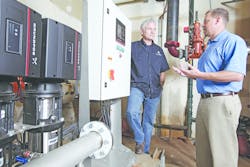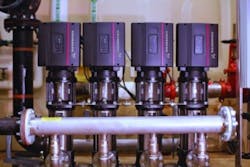Engineer Phil Boyd was originally looking for a repair option. A domestic water booster pump system at a downtown Seattle commercial property managed by Martin Selig Real Estate was failing, and rebuilding the 27-year-old pumps seemed to be the best solution.
After some research, Boyd discovered that upgrading to a more energy efficient system would be more cost effective. An integrated pressure boosting system could deliver the exact pressure necessary to achieve optimal performance without direct human intervention. It utilized a controller to adjust the pump speed and stage additional pumps as necessary to meet specific pressure demand — which was ideal for this situation.
The booster station serves a 43-story commercial office building at 1000 2nd Ave., located blocks from the Puget Sound waterway. Such high-rise buildings — including hotels, multifamily, office and other institutional applications — require pressure-boosting equipment to increase the incoming municipal water pressure to serve the upper floors. Demand for water in these buildings can vary significantly throughout the day, which puts extraordinary demands on pumping equipment.
An independent energy audit confirmed the cost efficiency of the new system. An energy optimization engineer traveled to the site to install the pump audit equipment onto the existing pressure boosting system, and the flow, power and pressure meter/loggers recorded performance data for a two-week period.
The data collected allowed him to select the best replacement system and was used to apply for utility incentives, which help boost the company’s return on this capital investment.
The existing system
The original pumping station used a system that was installed when the building was constructed in 1987.
"[Its one] 20-horsepower (hp) and two 30-hp vertical turbine pumps ran at full speed, and the pressure was controlled by pressure regulating valves that significantly reduced the system’s overall efficiency and would require scheduled annual maintenance," Boyd said.
Because of its simplistic control technology, one of the pumps ran 24 hours per day regardless of flow demands, which are significantly lower overnight and on weekends when the building is unoccupied. This scheme not only wasted electricity but also decreased the equipment’s life expectancy because of the excessive heat and hydraulic forces generated from operating with no flow demand.
Changing to a variable-speed, demand-based platform would also allow the building to apply for a utility incentive. The energy optimization engineer worked with Seattle City Light, a publicly owned electric power utility, to secure a large power reduction incentive for the property management customer. Like many utilities, its Energy Smart Services program works with medium and large businesses to reduce electricity use, save money and shorten the payback on energy-efficient investments.
After the new system was installed, Seattle City Light monitored power consumption for two weeks to compare the changes in load demand with the estimated power consumption in the new unit, according to Lisa Frasene, energy management analyst with Seattle City Light.
Incentives are based on total annual kilowatt hour (kWh) savings during the first year of the project, and combined rebates from all utilities cannot exceed 70 percent of project costs. The incentive amount is also capped to a minimum payback period of six months. The company offers an incentive rate of 27 cents per kWh reduction during the first year of operation for this type project.
The first year costs projected from the audit are:
- System cost — $61,521
- Utility incentive — +$29,328
- Annual cost/energy savings — +$7,604 (86 percent reduction with a savings of 108,624 kWh per year)
- Repair costs avoided — $17,000
- Total first year cost — $4,024
Frasene found that the high-efficiency, pressure boosting system would qualify for a one-time incentive payment of $29,328 with its annual estimated energy savings of 108,624 kWh or $7,604. The simple payback was estimated at 5.1 years, and each year after that, the business would save an estimated $7,600 in reduced electric bills.
Boyd recalls that the energy savings were impressive. "The new ‘right-sized’ water booster system has a lower initial cost than a ‘like-sized’ system [and] costs less to operate, and the utility incentive would pay for nearly half the system," he said.
Matching output with demand
The replacement system was equipped with efficient and reliable vertical multistage centrifugal pumps, and each pump was coupled to a 7.5-hp integrated variable-speed drive and motor. The multi-pump controller manages variable-frequency-drive-controlled pumps in parallel. The pump performance curves were loaded into the controller of the system, which selects the most efficient combination of pumps and pump speeds to match the flow and pressure demand.
The ability to adjust the pumping system output based on system demand enabled the energy efficiency savings of $7,604 per year; approximately $2,500 per year reduction in maintenance costs; and an average 86 percent reduction in energy use. In addition, the system was quiet and did not require maintenance, which saved an additional set of costs.
Success leads to similar upgrades
Following the success of the booster pump retrofit, Boyd received the go ahead for similar upgrades at two more downtown office buildings. The Fourth and Blanchard building at 2101 4th Ave. has 25 stories of offices that relied on a triplex boosting system with one 15-hp and two 25-hp fixed-speed pumps.
This pressure booster system delivers domestic water to the 43-story Martin Selig Real Estate building in Seattle.
The engineering team recommended replacing the existing system with a pressure boosting system that included three multistage centrifugal pumps, each controlled by 5-hp variable-speed pumps. First year costs projected from an audit indicate:
- System cost — $63,183
- Utility incentives — +$17,009
- Energy savings — +$5,055 per year (84 percent reduction wot savings of 63,000 kWh per year)
- Total first year cost — $41,119
The results from the Fourth and Blanchard building were similar to the 1000 2nd Ave. project, except the utility incentive was lower because the building is not as tall and the pump system was smaller and, therefore, consumed less energy.
An energy audit on a third property, a 12-story high-rise at 2401 2nd St., examined the building’s existing duplex pressure boosting system with full-speed, 5-hp, end-suction pumps. The power reduction in this third application yielded a 94 percent energy savings, but because of the system’s size, the kWh savings were less than the first two buildings, so the utility incentive was less. The proposed replacement system was equipped with two variable-speed 1.5-hp CRE pumps. The summary data for the project is:
- System cost — $ 47,383
- Utility incentives — +$6,700
- Energy savings — +$2,000 per year
- Total first year cost — $38,683
By replacing the pressure boosting system in these three commercial properties Martin Selig Real Estate realized the following results:
- Lower power consumption in each building
- Improved reliability of the pressure boosting systems and almost an elimination of the annual maintenance costs associated with each system
- Elimination of the obsolete systems’ costly repairs
- Increased property value
Brian James, P.E., is business development manager for Grundfos Pumps Corporation. He may be reached at [email protected]. Grundfos Pumps Corporation, part of the Grundfos Group, is a global pumps and pumping company serving the residential, commercial building, process industry, fire protection, water supply, wastewater and water treatment markets. For more information about the Grundfos Hydro MPC BoosterpaQ pressure boosting system, visit grundfos.us.



